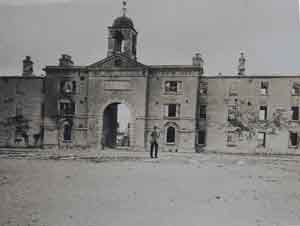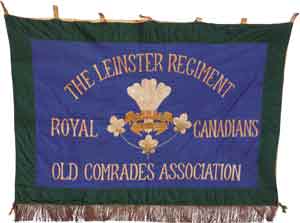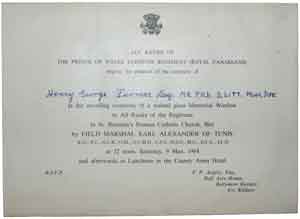DISBANDMENT, DESTRUCTION AND COMMEMORATION
Published in Features, Issue 4 (July/August 2022), Volume 30The Leinster Regiment, their depot and how they were commemorated in Birr, Co. Offaly.
By Stephen Callaghan

Above: Birr Barracks following its destruction by fire on the night of 14 July 1922 by anti-Treaty IRA. The fire reached the bell-tower at 3.30am, the hands on the clock freezing at that exact moment. (Offaly Archives)
Birr, Co. Offaly, is the spiritual home of the Leinster Regiment. The regiment was formed as part of the Childers reforms of the British Army in July 1881, with the amalgamation of the 100th and 109th Regiments of Foot to create the 1st and 2nd Battalions, Leinster Regiment. The 100th Foot had been raised in Canada in 1857—hence the Leinsters’ title ‘Royal Canadians’—and the 109th had been formed in India in 1853 by the Honourable East India Company. The reforms also saw the establishment of permanent regimental depots and recruiting areas based on geographical locations. For the Leinsters, their depot was Birr, with their recruiting areas being King’s County (Offaly), Queen’s County (Laois), Meath, Westmeath and Longford.
BIRR BARRACKS
The Leinsters’ regimental depot was in Birr Barracks. The barracks had been constructed at the height of the Napoleonic Wars, when the British had been fearful of a French invasion and internal insurrection in Ireland. A programme of fortification-building was implemented and a site in Crinkill was selected for a barracks in 1808, with construction beginning on 21 February 1809 and completed in 1812. The barracks consisted of two parade grounds, separated by the main soldiers’ accommodation block, with a central archway and turret clock tower. At the ends of the parade grounds, and perpendicular to the main soldiers’ block, were the officers’ quarters. There were many ancillary buildings, including a church, a canteen, married quarters, a magazine, a prison and gasworks. The adjacent field was the barracks training ground, known as the Fourteen Acres, where annual militia training camps would take place; mock trenches were even dug here during the First World War.
The 1st Battalion, Leinster Regiment, was stationed in Birr from late 1897 until 1898, when they moved to Canada for garrison duty; the 2nd Battalion was stationed in Birr in November 1882. Despite the short stays of the regular army battalions, the town retained a strong connection with the regiment, the depot staff being a permanent fixture of Birr Barracks along with annual militia training camps. In addition, many men from Birr and the surrounding environs who enlisted in Birr would be posted to one of the regular army battalions of the Leinsters. While Birr Barracks, Crinkill and Birr itself were no doubt important places for the Leinsters, it would be remiss not to acknowledge the many other regiments that were stationed there as part of their home service.
During the Leinsters’ existence, the regiment saw active service in various conflicts: a detachment served in the Fourth Anglo-Ashanti War (1895–6); the 1st, 2nd and 3rd Battalions served in the Second Boer War (1899–1902); and the 1st and 2nd Battalions, along with the newly raised 6th and 7th Service Battalions, served in various theatres during the Great War (1914–18), earning no less than four Victoria Crosses. The 1st Battalion later helped to suppress the Malabar rebellion (1921–2).
DISBANDMENT

Above: Banner of the Leinster Regiment’s Old Comrades Association (OCA), initially formed in May 1913. It remained active after disbandment in June 1922. (Edel Barnwell and Des Nix)
With the Anglo-Irish Treaty and severe cutbacks in the British Army, the Leinster Regiment, along with five other historic southern Irish regiments, was earmarked for disbandment. As part of the agreement, the British Army was to leave Ireland, and the depot staff of the Leinster Regiment left Birr Barracks on 2 February 1922. The departing staff consisted of four officers, 64 men, two women and eight children, along with two wagons full of luggage. Upon leaving the barracks, the Leinsters were greeted by a large crowd of locals as they marched down Military Road for the last time, with the regiment’s band playing several Irish and traditional tunes. At Birr railway station they boarded the train for Dublin, and then made their way to the North Wall and proceeded, via Holyhead, to join the 2nd Battalion in Colchester. A detachment of soldiers of the Northamptonshire Regiment remained behind to oversee a large auction of the government stores, which was scheduled to take place on 3 February, and also to hand over the barracks to the newly formed National Army. The barracks was handed over to Commandant General Michael McCormack, 3rd Southern Division, on 6 February.
The disbandment of the Leinsters took place at Windsor Castle on 12 June 1922. The colours of the 1st and 2nd Battalions, Leinster Regiment, were surrendered to King George V for safe keeping, along with the colours of the other Irish regiments to be disbanded.
DESTRUCTION
The Leinsters’ former depot, Birr Barracks, had been in the hands of the National Army for less than a month when the Civil War broke out. The anti-Treaty IRA gained control on the night of 14 July and set the barracks alight. The fire blazed into the early hours of the morning and could be seen for miles around. The fire reached the bell-tower at 3.30am, the hands on the clock freezing at that exact moment. There was talk of rebuilding the barracks in 1923 and in the 1940s, but nothing came of it and the buildings were eventually sold off for rubble.
COMMEMORATION

Above: The memorial stained-glass window unveiled by Earl Alexander of Tunis on 9 May 1964 in St Brendan’s Catholic church, Birr, and (right) an invitation to Henry Farmer to the unveiling. (Offaly Archives)
Even prior to disbandment and the destruction of the barracks, an Old Comrades Association (OCA) had existed. Initially formed in May 1913, it remained quite active after disbandment. The Irish branch of the OCA visited Birr annually for the blessing of graves in the old military cemetery, which had catered for the military burials of Birr Barracks. Wreaths were also laid at the memorial to the men of the 3rd (Militia) Battalion who died in the Second Boer War, the memorial having been moved here from the ruined barracks grounds in 1925.
In the 1960s a memorial stained-glass window was commissioned to commemorate all ranks who served in the regiment. The window was a gift from Mr Michael Dunne of Hatch Street, Dublin (son-in-law of Captain Kelly, a prominent member of the OCA). It was placed on the Gospel side of St Brendan’s Catholic church in Birr, immortalising the regiment’s links with the town. The window was unveiled at 12 noon on 9 May 1964 by Earl Alexander of Tunis, a decorated field marshal of the Second World War. The Earl was quoted as saying that ‘Birr is the most fitting place to give the Leinster Regiment honour’. Mass was celebrated by Monsignor Michael Quinn PP.
The Gothic-style two-light window depicts the crucifixion of Christ in the left-hand panel, with the following text below:
IN MEMORY OF ALL RANKS OF THE
PRINCE OF WALES’S LEINSTER
REGIMENT (ROYAL CANADIANS)
WHOSE DEPOT WAS AT CRINKLE [sic]
BIRR 1881–1921.
The right-hand panel depicts the Archangel Michael, with the following text below:
BATTLE HONOURS ON COLOURS—
NIAGARA, CENTRAL INDIA, SOUTH
AFRICA, AISNE 1914, YPRES 1915-17-18
SOMME 1916–18, GUILLEMONT, VIMY 1917
MESSINES 1917, ST QUENTIN, MACEDONIA
GALLIPOLI 1915, JERUSALEM.
The quatrefoil above bears the regiment’s cap badge.
Interestingly, the event was filmed by British Pathé and the recording is still available on its website, britishpathe.com. The four-minute-long silent video shows the Earl arriving by car at the church and being greeted by veterans of the regiment and locals. Inside the packed church the window is unveiled and blessed, with a bugler present, presumably sounding The Last Post. After the unveiling we move back outside, with the Earl meeting other Great War veterans and excited children running around. One Old Contemptible is decorated with the Distinguished Conduct Medal, and one veteran with an eye-patch is wearing an India General Service medal with the clasp ‘Malabar 1921–22’ in addition to his Great War medals. The suppression of the Malabar rebellion was the last campaign of the Leinster Regiment—and, for that matter, of any other southern Irish regiment. The Leinster Regiment OCA banner can be seen flapping in the breeze. The video concludes with another notable guest, John Moyney, a Laois-born Great War veteran who was awarded the Victoria Cross in September 1917.
The window has since been moved to the south transept of the church, where it remains today, an important reminder of Birr’s connections to this famous British Army regiment.
Stephen Callaghan is an independent scholar.
Further reading
S. Callaghan, Birr Military Cemetery—a history of the cemetery and those interred there (Tullamore, 2020).
T. Dunne, ‘The Leinster Regiment and the Malabar rebellion of 1921—“another Irish question”’, History Ireland 29 (4) (2021).
Lt. Col. F.E. Whitton, The history of the Prince of Wales’s Leinster Regiment (Royal Canadians) (Uckfield, 2016).

















